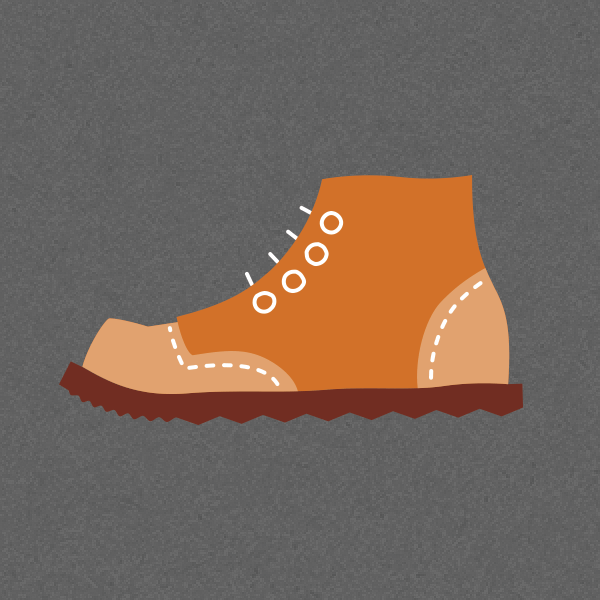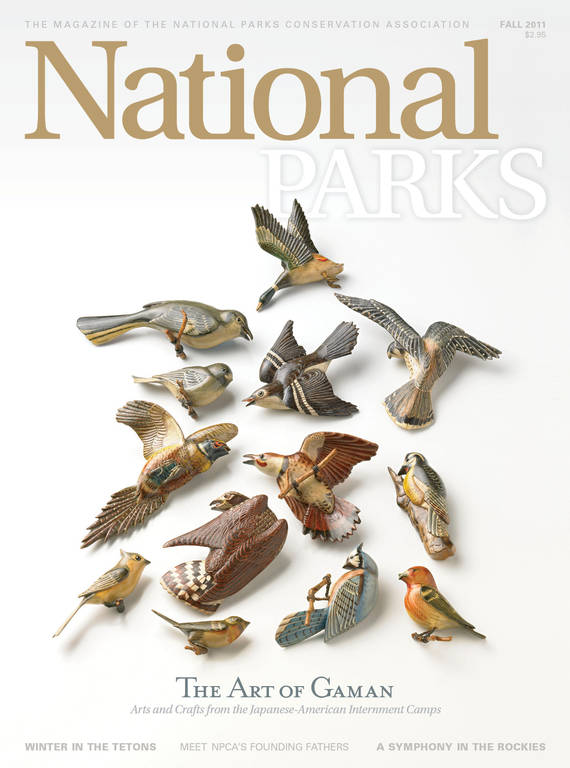Fall 2011
The Art of Gaman
Bearing the seemingly unbearable with patience and dignity.
A few months after my mother’s death in 2000, I was rummaging through my parents’ garage when I happened across a dusty little wooden box. Inside, I discovered an odd assortment of things, including a tiny wooden bird pin with a safety-pin clasp, and trinkets that my father must have brought back from Italy, where he served with the all-Nisei 442nd Regimental Combat Team during World War II. Given the contents of the box, I figured that these were things stashed away after “camp.”
“Camp” is how my parents referred to the Japanese-American internment camps located in remote and desolate regions of the United States during World War II. They were created after President Franklin D. Roosevelt signed Executive Order 9066 on February 19, 1942, giving the U.S. Army authority to exclude anyone it deemed necessary from prescribed areas in the name of military defense. Within weeks of the signing of E.O. 9066, all 120,000 ethnic Japanese living on the West Coast were ordered into internment camps surrounded by barbed-wire fences and guarded by sentries in watch towers with guns pointed at them. The so-called evacuation forbade any exceptions. As a result, anyone of Japanese descent—men, women, children, the elderly, orphans as young as three months old, and hospital patients—were forcibly sent into camp. Those incarcerated represented 90 percent of the ethnic Japanese in the United States; two-thirds were American citizens born on American soil (the immigrant generation was not allowed to apply for citizenship).
NPCA @WORK
The ethnic Japanese on the West Coast were given about a week to settle their affairs and allowed to take only what they could carry. As a result, homes and businesses were lost. Belongings had to be sold for pennies on the dollar. Possessions that were put in storage were stolen or vandalized. Release from camp after three and a half years inevitably meant starting life over from scratch.
Ironically, I knew little of this as a child growing up in California. As with most post-war Japanese-American families, my parents never discussed the camps openly with their kids, nor was the subject taught in schools or mentioned by mainstream society. Yet for my parents’ generation, time was divided into life “before camp” and “after camp.” In passing conversation, they would mention “we had one before camp,” “we had to buy a new one after camp,” “we knew them from camp.” Often this was followed by a pause and then, as if shaking off despair, they would quickly add, “Shikataganai. It can’t be helped. We have to gaman—bear the seemingly unbearable with patience and dignity.”
Finding the little bird pin nearly 60 years after the camps closed, however, got me wondering what other things made in camp lay hidden away and forgotten. I asked around, and family friends began stopping by with objects tossed into the trunks of their cars, some still in wrapping from 1945.
I was astonished by the variety, artistry, imagination, and craftsmanship of the things that they brought. The objects, made from scrap and found materials, ranged from ordinary things such as a hand-made wooden washboard and containers woven out of twisted crepe paper to an intricately decorated teapot carved from slate.
Many items were obviously made out of necessity, because the horse stalls where the internees first lived contained only a metal cot and mattress ticking to be filled with straw. A few months later, most of the internees were sent to live in barrack encampments in remote desert areas. The barracks weren’t furnished any better. A chair to sit on, and a place to store belongings were immediate needs. Fortunately, the haste with which these quarters were built left plenty of scrap lumber scattered on the grounds, and the internees quickly salvaged every piece to construct chairs, tables, and even clothes hangers. Because internees could not bring metal objects into camp, they generally had to devise their own tools, too. Sharpened butter knives, discarded metal from the automotive pool, and even abandoned animal traps found on the ground, all were repurposed into tools; internees even fashioned sandpaper by gluing crushed glass onto pieces of cardboard.
Although internees were allowed to buy goods via mail-order catalogs, the little money they had was generally set aside for clothing and other essentials; buying almost anything else was considered a luxury. As a result, internees scrounged for scraps of every kind: Waxy string from onion sacks was unraveled and woven into baskets. Old toothbrush handles were turned into pendants. Gallon-sized mayonnaise jars became miniature display cases for fragile pieces of art. Tin cans were converted into toy trains. Peach pits were scraped smooth against cement and gouged in the center to make rings. Produce crates were chopped into blocks and carved into bird pins. Even meat bones, gnawed clean during dinner, were crosscut into circles and linked together through the softer marrow portion to create jewelry. Nothing was viewed as waste.
The terrain itself offered up a wealth of indigenous materials. Camps at Tule Lake in northern California and at Topaz in Utah were located on ancient seabeds that yielded millions of tiny shells that could be bleached, sorted, and formed into brooches and ornaments. The camp in Minidoka, Idaho, was littered with pebbles that internees would cement into containers, polish into jewelry, and use as a “canvas” for miniature paintings. The desert surrounding the camps at Gila and Poston—both located on Indian reservations in Arizona—grew ironwood, cacti, and mesquite that could be carved into objects both practical and beautiful. The forested swamps of southeastern Arkansas, where Rohwer and Jerome camps were located, offered an abundance of hardwood and pine.
Arts and crafts became an obsession in the camps. As a distraction from their plight, internees embraced such endeavors to pass the time and to enjoy the satisfaction of making something that emerged from their own imagination and industriousness. All ten of the internment camps organized classes in arts and crafts, both formal and informal, taught by internees who had been professional artists and by others who exhibited a specific skill. Other internees simply tested their own creativity, trying their hand at everything from wood carving to sand sculptures.

National Parks
You can read this and other stories about history, nature, culture, art, conservation, travel, science and more in National Parks magazine. Your tax-deductible membership donation of $25 or more entitles…
See more ›In looking at the works of art the internees created, it’s hard to believe that so few of them had any formal art training. Before their lives were abruptly interrupted, they were farmers, shopkeepers, doctors, fishermen, homemakers, and clerks. After they were released from camp, most struggled to eke out a living and abandoned their artistic pursuits. Because they did not view themselves as artists and because nearly everyone in camp was busy producing similar things, they didn’t see much value in what they had made, and many threw their handicraft away. The objects were nothing more than painful reminders of a time they wished to forget.
By the time I began asking if anyone had objects made in camp for use in a book I intended to write, most of the makers of these objects had died. Their children, now in their 70s and 80s themselves, kindly went into their attics and storage sheds in search of long-forgotten items. When showing me what they had uncovered, many told me it was all right to leave the object out if I didn’t find its quality book-worthy. “It was just busy work,” they’d explain, “a way to gaman.” Even the humblest works, however, had poignancy, evoking images of the conditions under which they were made.
Today the sites of the World War II internment camps have largely reverted back to desert. On the barren land, the sand swirls and settles down on the traces of barrack foundations as if to try to erase this sad episode in American history. What remains in the arts and crafts produced by internees is evidence of the triumph of the human spirit, the true art of gaman.
About the author
-
 Delphine Hirasuna Contributor
Delphine Hirasuna ContributorDelphine Hirasuna is an editor of @Issue: Journal of Business and Design, online at www.atissuejournal.com. She is the co-author of several nonfiction books and was a feature columnist for two Japanese-American newspapers for more than 25 years.



